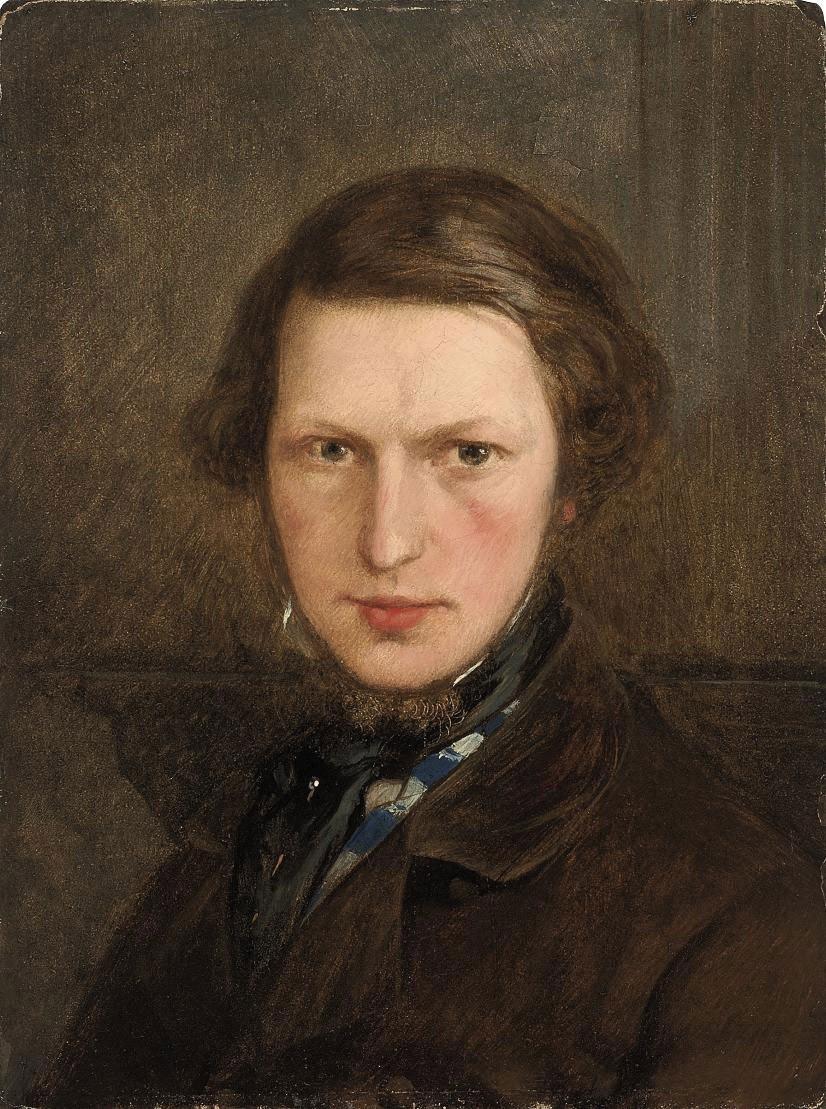Created by Natalia Salamon on Fri, 10/23/2020 - 20:11
Description:
Ford Madox Brown was a Franco-English painter (See Figure 1). His father was a retired purser from the Royal Navy and his mother came from Kent. His grandfather, John Brown, founded the Brunonian system of medicine. He was an only child. Ford’s education was limited as his childhood was spent traveling between England and the rest of Europe. His interest in painting arose at the age of six. His strength in his talent was not portrayed until he completed a portrait of his father at the age of fourteen where he showed the fine details of his father’s solemn expression (see Figure 2). At the age of nineteen he lost both his parents. Ford Madox Brown was twice married. First, in 1841 to his cousin, Elizabeth Bromley whom they had two children with: their first died as an infant, and their daughter Emma (Sizeranne 80 - 81). In 1846, Elizabeth contracted tuberculosis which lead to her death. Shortly after, Brown remarried to Emma Hill who posed is many of his paintings.
In 1843, there was a prestigious competition hosted in London to decorate the new Palace of Westminster. This gave the opportunity for smaller artists to stand out. Out of the one hundred and forty entries, Ford Madox Brown entered five of his compositions, one of them being The Body of Harold Brought before William The Conqueror (see Figure 3) (Sizeranne xiii-xiv). Although unsuccessful in the competition, Brown’s work raised certain attention from admirers. Dante Gabriel Rosetti was intrigued by Brown’s work and painting technique and went on to write to him, asking for art lessons. Brown took Rosetti as a mentor and worked under his supervision, gaining the precision he had not yet attained by anyone else. (Sizeranne 74).
Ford Madox Brown’s art introduced modern-life subject matter to the art world and to the Pre- Raphaelite Brotherhood. His modern life portrayal can be seen as a subset to history painting. He revolutionized replacing traditional history painting context with temporalities such like: “times history, the timeless, and the modern perspective” (Prettlejohn 239). His goal was to break through the generic history painting and include modern representation, and present-day ideology (Prettlejohn 241). One of his most important pieces that portray his modern life is The Last Day of England. The piece depicts a man and woman sitting in a crowded steamboat, very likely middle class. There is evidence of sharp and vibrant colors accompanied around dull shades. The more one studies the painting, more drama unfolds behind this couple, their environment, and their distant gaze. Rossetti praised Brown for his compelling realist effect in an article published in the London Daily News (Prettlejohn 239-240). Rossetti built a strong connection to Brown’s composition of an intense expression of human life which allowed for a sensory experience (Trodd 232). Additionally, the most popular painting of Brown is Work. Overloaded with detail, this painting depicts chaos- various artisans, “pressing, and pushing and knocking up against each other” in a village. The use of bright colors such as red and blue on the clothing distracts from the chaos. This painting visualizes the changing Victorian social system from a rural to urban economy (Trodd 233).
Brown’s art related to his own troubling political and ethical opinions. His contemporary style elaborated on the true circumstances he was living around. His paintings were only a small depiction of the true problems going on in the nineteenth-century- such like inequity of the class system or estrangement in the social life. What was interesting about Brown’s modern-life subject-matter paintings was the contrast of its expectation. It was normal for historical subject-matter paintings to represent deep, meaningful events whereas modernist style paintings showed the lighter topics of everyday life (Prettlejohn 242). Instead, his messages were clear behind capturing present day issues with the “weight and ethical seriousness of traditional history painting,” (Prettlejohn 243).
Apart from modern style art, ironically, historical and religious subject matter dominated Brown’s painting career. During 1845-1846, Ford Madox Brown explored Rome. There, he studied the work of the Nazarenes. This nineteenth century group of German painters believed “art should serve a moral or religious purpose”. Their name derived from the Biblical context and their association to Biblical hair and dress (“Nazarene”). Although never an official member of the Pre Raphaelite- Brotherhood, Brown’s art contributed to the Brotherhood’s beginnings of their aesthetic revolution: the use of realism in historic or religious context, incorporating bright colors and attention to detail.
Bibliography
“Nazarene.” Encyclopædia Britannica, Encyclopædia Britannica, Inc., www.britannica.com/art/Nazarene-Brotherhood
Prettejohn, Elizabeth. “Ford Madox Brown and History Painting.” Visual Culture in Britain, vol. 15, no. 3, Nov. 2014, pp. 239–257. EBSCOhost, doi:10.1080/14714787.2014.947558
Sizeranne, Robert de la. The Pre-Raphaelites, Parkstone International, 2008. ProQuest Ebook Central, https://ebookcentral.proquest.com/lib/depaul/detail.action?docID=887076
Trodd, Colin, and Julie Sheldon. “Introduction: Ford Madox Brown and the Victorian Imagination.” Visual Culture in Britain, vol. 15, no. 3, Nov. 2014, pp. 227–238. EBSCOhost, doi:10.1080/14714787.2014.945806




